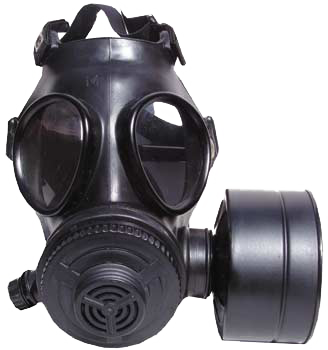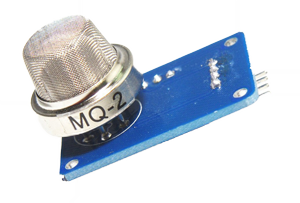

There are quite a few different gas sensors you can use together with MySensors. Detect alcohol, methane (fart-sensor?), fire etc. We list a few in the buying guide below.
The example provided here uses the MQ2 sensor to detect air quality.
Wiring Things Up
Start by connecting the radio module.
| Sensor | Arduino | Comment |
|---|---|---|
| VCC | +5V | - |
| GND | GND | - |
| A-out | A0 | - |
Example
/*
* The MySensors Arduino library handles the wireless radio link and protocol
* between your home built sensors/actuators and HA controller of choice.
* The sensors forms a self healing radio network with optional repeaters. Each
* repeater and gateway builds a routing tables in EEPROM which keeps track of the
* network topology allowing messages to be routed to nodes.
*
* Created by Henrik Ekblad <[email protected]>
* Copyright (C) 2013-2019 Sensnology AB
* Full contributor list: https://github.com/mysensors/MySensors/graphs/contributors
*
* Documentation: http://www.mysensors.org
* Support Forum: http://forum.mysensors.org
*
* This program is free software; you can redistribute it and/or
* modify it under the terms of the GNU General Public License
* version 2 as published by the Free Software Foundation.
*
*******************************
*
* DESCRIPTION
*
* Connect the MQ2 sensor as follows :
*
* A H A >>> 5V
* B >>> A0
* H >>> GND
* B >>> 10K ohm >>> GND
*
* Contribution: epierre
* Based on http://sandboxelectronics.com/?p=165
* License: Attribution-NonCommercial-ShareAlike 3.0 Unported (CC BY-NC-SA 3.0)
* Modified by HEK to work in 1.4
*
*/
// Enable debug prints to serial monitor
#define MY_DEBUG
// Enable and select radio type attached
#define MY_RADIO_RF24
//#define MY_RADIO_NRF5_ESB
//#define MY_RADIO_RFM69
//#define MY_RADIO_RFM95
#include <MySensors.h>
#define CHILD_ID_MQ 0
/************************Hardware Related Macros************************************/
#define MQ_SENSOR_ANALOG_PIN (0) //define which analog input channel you are going to use
#define RL_VALUE (5) //define the load resistance on the board, in kilo ohms
#define RO_CLEAN_AIR_FACTOR (9.83) //RO_CLEAR_AIR_FACTOR=(Sensor resistance in clean air)/RO,
//which is derived from the chart in datasheet
/***********************Software Related Macros************************************/
#define CALIBARAION_SAMPLE_TIMES (50) //define how many samples you are going to take in the calibration phase
#define CALIBRATION_SAMPLE_INTERVAL (500) //define the time interval(in milliseconds) between each samples in the
//calibration phase
#define READ_SAMPLE_INTERVAL (50) //define how many samples you are going to take in normal operation
#define READ_SAMPLE_TIMES (5) //define the time interval(in milliseconds) between each samples in
//normal operation
/**********************Application Related Macros**********************************/
#define GAS_LPG (0)
#define GAS_CO (1)
#define GAS_SMOKE (2)
/*****************************Globals***********************************************/
uint32_t SLEEP_TIME = 30000; // Sleep time between reads (in milliseconds)
//VARIABLES
float Ro = 10000.0; // this has to be tuned 10K Ohm
int val = 0; // variable to store the value coming from the sensor
uint16_t lastMQ = 0;
float LPGCurve[3] = {2.3,0.21,-0.47}; //two points are taken from the curve.
//with these two points, a line is formed which is "approximately equivalent"
//to the original curve.
//data format:{ x, y, slope}; point1: (lg200, 0.21), point2: (lg10000, -0.59)
float COCurve[3] = {2.3,0.72,-0.34}; //two points are taken from the curve.
//with these two points, a line is formed which is "approximately equivalent"
//to the original curve.
//data format:{ x, y, slope}; point1: (lg200, 0.72), point2: (lg10000, 0.15)
float SmokeCurve[3] = {2.3,0.53,-0.44}; //two points are taken from the curve.
//with these two points, a line is formed which is "approximately equivalent"
//to the original curve.
//data format:{ x, y, slope}; point1: (lg200, 0.53), point2:(lg10000,-0.22)
MyMessage msg(CHILD_ID_MQ, V_LEVEL);
void setup()
{
Ro = MQCalibration(
MQ_SENSOR_ANALOG_PIN); //Calibrating the sensor. Please make sure the sensor is in clean air
}
void presentation()
{
// Send the sketch version information to the gateway and Controller
sendSketchInfo("Air Quality Sensor", "1.0");
// Register all sensors to gateway (they will be created as child devices)
present(CHILD_ID_MQ, S_AIR_QUALITY);
}
void loop()
{
uint16_t valMQ = MQGetGasPercentage(MQRead(MQ_SENSOR_ANALOG_PIN)/Ro,GAS_CO);
Serial.println(val);
Serial.print("LPG:");
Serial.print(MQGetGasPercentage(MQRead(MQ_SENSOR_ANALOG_PIN)/Ro,GAS_LPG) );
Serial.print( "ppm" );
Serial.print(" ");
Serial.print("CO:");
Serial.print(MQGetGasPercentage(MQRead(MQ_SENSOR_ANALOG_PIN)/Ro,GAS_CO) );
Serial.print( "ppm" );
Serial.print(" ");
Serial.print("SMOKE:");
Serial.print(MQGetGasPercentage(MQRead(MQ_SENSOR_ANALOG_PIN)/Ro,GAS_SMOKE) );
Serial.print( "ppm" );
Serial.print("\n");
if (valMQ != lastMQ) {
send(msg.set((int16_t)ceil(valMQ)));
lastMQ = ceil(valMQ);
}
sleep(SLEEP_TIME); //sleep for: sleepTime
}
/****************** MQResistanceCalculation ****************************************
Input: raw_adc - raw value read from adc, which represents the voltage
Output: the calculated sensor resistance
Remarks: The sensor and the load resistor forms a voltage divider. Given the voltage
across the load resistor and its resistance, the resistance of the sensor
could be derived.
************************************************************************************/
float MQResistanceCalculation(int raw_adc)
{
return ( ((float)RL_VALUE*(1023-raw_adc)/raw_adc));
}
/***************************** MQCalibration ****************************************
Input: mq_pin - analog channel
Output: Ro of the sensor
Remarks: This function assumes that the sensor is in clean air. It use
MQResistanceCalculation to calculates the sensor resistance in clean air
and then divides it with RO_CLEAN_AIR_FACTOR. RO_CLEAN_AIR_FACTOR is about
10, which differs slightly between different sensors.
************************************************************************************/
float MQCalibration(int mq_pin)
{
int i;
float inVal=0;
for (i=0; i<CALIBARAION_SAMPLE_TIMES; i++) { //take multiple samples
inVal += MQResistanceCalculation(analogRead(mq_pin));
delay(CALIBRATION_SAMPLE_INTERVAL);
}
inVal = inVal/CALIBARAION_SAMPLE_TIMES; //calculate the average value
inVal = inVal/RO_CLEAN_AIR_FACTOR; //divided by RO_CLEAN_AIR_FACTOR yields the Ro
//according to the chart in the datasheet
return inVal;
}
/***************************** MQRead *********************************************
Input: mq_pin - analog channel
Output: Rs of the sensor
Remarks: This function use MQResistanceCalculation to calculate the sensor resistance (Rs).
The Rs changes as the sensor is in the different concentration of the target
gas. The sample times and the time interval between samples could be configured
by changing the definition of the macros.
************************************************************************************/
float MQRead(int mq_pin)
{
int i;
float rs=0;
for (i=0; i<READ_SAMPLE_TIMES; i++) {
rs += MQResistanceCalculation(analogRead(mq_pin));
delay(READ_SAMPLE_INTERVAL);
}
rs = rs/READ_SAMPLE_TIMES;
return rs;
}
/***************************** MQGetGasPercentage **********************************
Input: rs_ro_ratio - Rs divided by Ro
gas_id - target gas type
Output: ppm of the target gas
Remarks: This function passes different curves to the MQGetPercentage function which
calculates the ppm (parts per million) of the target gas.
************************************************************************************/
int MQGetGasPercentage(float rs_ro_ratio, int gas_id)
{
if ( gas_id == GAS_LPG ) {
return MQGetPercentage(rs_ro_ratio,LPGCurve);
} else if ( gas_id == GAS_CO ) {
return MQGetPercentage(rs_ro_ratio,COCurve);
} else if ( gas_id == GAS_SMOKE ) {
return MQGetPercentage(rs_ro_ratio,SmokeCurve);
}
return 0;
}
/***************************** MQGetPercentage **********************************
Input: rs_ro_ratio - Rs divided by Ro
pcurve - pointer to the curve of the target gas
Output: ppm of the target gas
Remarks: By using the slope and a point of the line. The x(logarithmic value of ppm)
of the line could be derived if y(rs_ro_ratio) is provided. As it is a
logarithmic coordinate, power of 10 is used to convert the result to non-logarithmic
value.
************************************************************************************/
int MQGetPercentage(float rs_ro_ratio, float *pcurve)
{
return (pow(10,( ((log(rs_ro_ratio)-pcurve[1])/pcurve[2]) + pcurve[0])));
}
Gas Sensor Comparison
| Sensor | Detects | Heater Voltage |
|---|---|---|
| MQ-2 | Methane, Butane, LPG, smoke | 5V |
| MQ-3 | Alcohol, Ethanol, smoke | 5V |
| MQ-4 | Methane, CNG Gas | 5V |
| MQ-5 | Natural gas, LPG | 5V |
| MQ-6 | LPG, butane gas | 5V |
| MQ-7 | Carbon Monoxide | Alternating 5V and 1.4V |
| MQ-8 | Hydrogen Gas | 5V |
| MQ-9 | Carbon Monoxide, flammable gasses. | Alternating 5V and 1.4V |
| MQ131 | Ozone | 6V |
| MQ135 | Air Quality (Benzene, Alcohol, smoke) | 5V |
| MQ136 | Hydrogen Sulfide gas | 5V |
| MQ137 | Ammonia | 5V |
| MQ138 | Benzene, Toluene, Alcohol, Acetone, Propane, Formaldehyde gas, Hydrogen | 5V |
| MQ214 | Methane, Natural gas | 6V |
| MQ216 | Natural gas, Coal gas | 5V |
| MQ303A | Alcohol, Ethanol, smoke | 0.9V |
| MQ306A | LPG, butane gas | 0.9V |
| MQ307A | Carbon Monoxide | Alternating 0.2V and 0.9V. |
| MQ309A | Carbon Monoxide, flammable gasses | Alternating 0.2V and 0.9V |
| MG811 | Carbon Dioxide (CO2) | 6V |
| AQ-104 | Air quality | - |